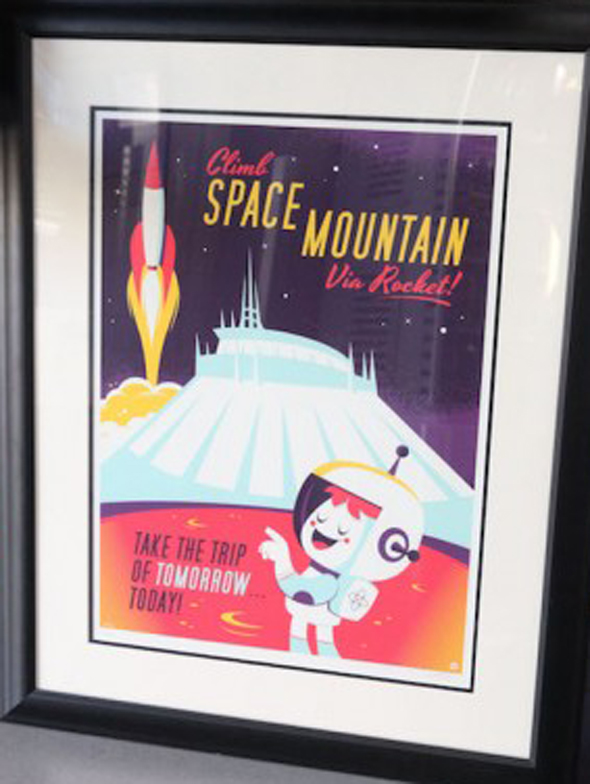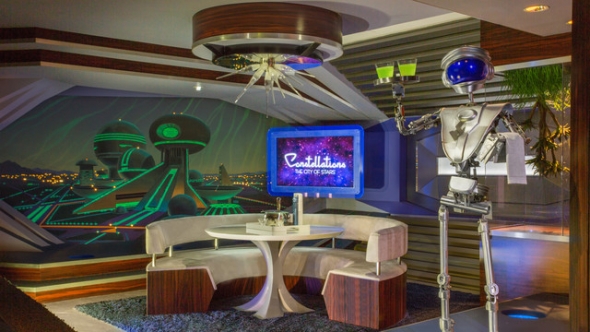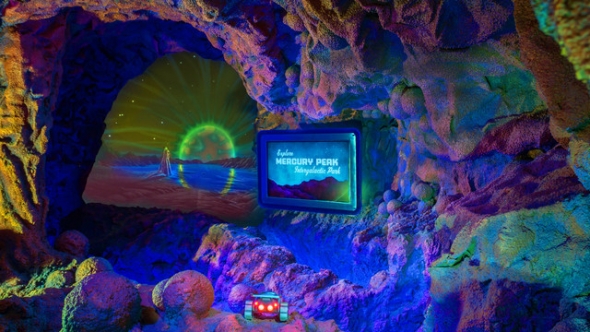The plan starts to come together

Image: Disney
Emboldened by the popularity of the outer space films and the public’s embracing of the Matterhorn Bobsleds, the geniuses at WED Enterprises plotted to merge the two premises. They wanted to construct an attraction that would simulate outer space travel. They already had von Braun, the expert on the subject, at their disposal. What they had to do as a group was identify what would become the hallmarks of such a journey. It was harder than you might think.
In the days before computers could be held in one’s hand, the ability to calculate the appropriate trajectories for a launch sequence proved almost impossible to most. That’s one of the reasons why von Braun grew into an icon in the space age. He could perform incredible calculations, visualizing aspects of space travel that nobody else understood. Years later, when man actually went into outer space, many of his most arcane equations proved eerily accurate. He was effectively a wizard to others, and his input aided Imagineers in blocking out the basic schematics of their new attraction.
The German scientist also worked diligently to maintain his relationship with Disney execs. During the years leading up to the first Moon landing, von Braun hosted several Imagineers at the Huntsville, Alabama facility, the finest in the world at the time. Perhaps better than anyone else other than Walt Disney, who was in fading health by this point, von Braun appreciated that publicity was integral to space travel. He understood that many of his youngest employees worked at NASA due to their earlier exposure with the three Disney television programs more than a decade earlier. He wanted to keep that pipeline going, and he understood Disney provided the best option to do that. An outer space attraction at Disneyland, the only existing theme park at the time, would accomplish this goal. The mutual interest in the project was ultimately critical to its survival during a rough period.
The Space Mountain prequels
Image: Disney
While the numbers may run together for you as we discuss Disney history, they didn’t for the staff members. The time from the debut of Disneyland in 1955 until 1964 indicates a decade of park operation. Think about how much current Disney parks have changed in the last 10 years and then consider how much change occurred in the time from the invention of the theme park until it’s stayed open for ten years. Conditions on some rides were already problematic enough that Walt Disney felt frustration. As any software developer will tell you, the maintenance phase is when the true work occurs.
Disneyland’s issues were particularly keen in one themed area. Tomorrowland was supposed to exemplify the world of the future, the one the grandkids of opening day park guests would enjoy. Unfortunately, it suffered from the same problem that we’ve witnessed with Epcot over the years. The future happens much faster than you might expect. To wit, the social media era is about the same age as Disneyland was in 1955. It’s hard to remember a time when you couldn’t quickly send a message to your friends about how your day is going, right? In the 1950s, technology wasn’t moving quite that quickly, but it was still problematic enough that Tomorrowland was starting to seem more like Neverland crossed with AlreadyHereLand.
To stave off this concern, Uncle Walt planned numerous park updates and upgrades to restore the luster of his prized enterprise. One of his most ambitious plans was the idea he’d plotted with von Braun and other NASA experts on space travel. Disney would build something worthy of the Space Age. The Imagineers quickly determined that the best way to accomplish this grand ambition was to circle back to a couple of established tactics. The new ride would reside in a meticulously themed area, and the area would comprise a mountain. Since its inception, Disneyland had consisted of several themed lands, and man-made constructs such as Sleeping Beauty Castle and the mountain surrounding the Matterhorn Bobsleds grabbed attention in jaw-dropping fashion.
You’ve likely already done the math here and realized that Space Mountain didn’t debut first at Disneyland. Let’s retrace the steps of how the plans originated and then discuss how the world’s first dark ride roller coaster wound up at Walt Disney World instead. It all begins with one of the longest tenured employees in the history of The Walt Disney Company.
The Squid Guy Heads to Space
Image: Disney
John Hench might not be a name you know among the cast of amazing Disney Imagineers over the years, and that’s tragic. Hench started with the company in 1939 and stayed with Disney until his retirement in 2004, only weeks before his death at the age of 95. If you’re doing the math, you’re not crazy. He worked at Disney for 65 years, more than two thirds of his life. I can’t say this for certain but at the time of his retirement, I strongly suspect that he had seniority over EVERYBODY in the company.
A story artist by trade, Hench worked his way up the corporate ladder in remarkable fashion. Only a few years into his tenure, he generated acclaim for Destino, a joint project with an artist you might know by the name of Salvador Dalí. If the project sounds familiar to you, there’s a good explanation for that, too. The two artists crafted Destino in 1945 and 1946, but Disney as a company was too broke due to World War II to release it. Destino’s actual release came almost 60 years later in 2003. Still, everyone in the company knew how good it was and lamented what transpired. Hench’s status grew.
By 1954, Uncle Walt trusted his artist enough that Hench received a plum assignment. He would work as the lead developer on an unusual project, even by the odd standards of Disney. Hench would build a giant hydraulic squid for 20,000 Leagues under the Sea, a critical movie release that had lingering impact on Disney theme parks as well. Hench performed so well that his company earned an Academy Award for Best Special Effects for the fake but terrifying squid. It was probably this achievement that anchored Hench’s candidacy as an official Disney Legend. From that point forward, he was always the Squid Guy. A different project better encapsulates his legacy, though.
Walt Disney chose Hench to head up a project that the Disneyland creator called Space Port. Three other Imagineers joined the Space Port team soon afterward. Clem Hall, George McGinnis, and Herb Ryman worked together to illustrate concept art for the new attraction. Once they had the specs ready, Disney asked them to team with Arrow Development Company, the same manufacturers who had built the revolutionary tracks for the Matterhorn Bobsleds.
Uncle Walt had grand ambitions for his new space travel simulator. He intended to double the number of coaster tracks from the two employed by the Matterhorn Bobsleds. Space Mountain would stretch out across four of them, providing thrill seekers with constant entertainment. More prudent from Disney’s perspective was that four operating ride carts would lead to tremendous ride throughput for Space Port. It could easily service Disneyland’s tiny part of the galaxy.



Add new comment